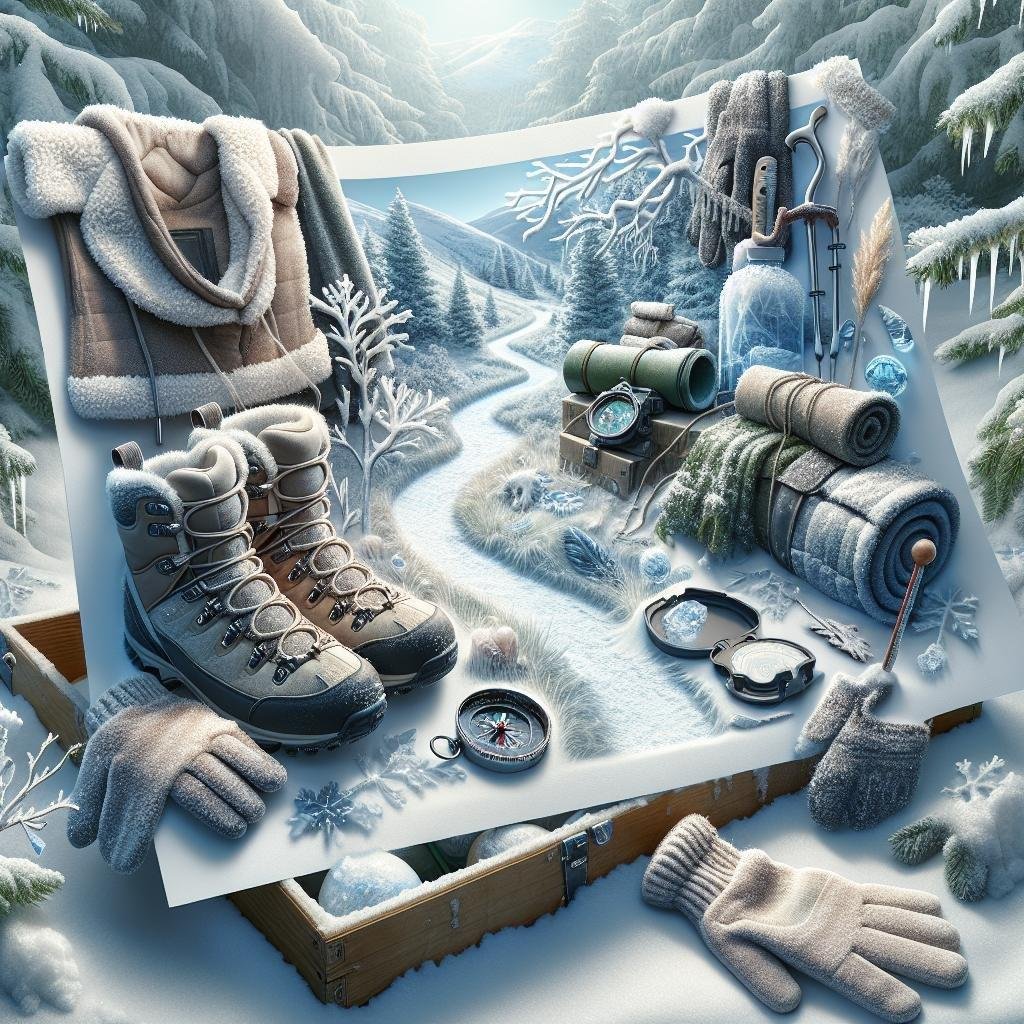As the first snowflakes begin their gentle descent, transforming familiar landscapes into winter wonderlands, a special magic envelops the trails. For the adventurous soul, winter offers a unique invitation—a chance to embrace solitude on still paths, to marvel at frost-clad trees shimmering like they’re sprinkled with stardust, and to renew one’s connection with nature in its most tranquil state. But beneath the serene beauty lies the challenge of navigating these trails under cold and unpredictable conditions. This article delves into the world of winter hiking, offering essential tips and insights for those eager to explore nature’s frosty embrace safely. Whether you’re a seasoned cold-weather trekker or a curious newcomer, prepare to lace up your boots and discover the quiet splendor of winter hiking.
Preparing Your Gear for a Winter Wonderland
Ensuring you have the right equipment for a snowy trek is crucial for both comfort and safety. Start by layering your clothing—think base layers for moisture wicking, insulating layers for warmth, and outer layers to shield against wind and snow. Your choice of boots can rapidly change the experience from a pleasurable outing into a formidable challenge. Aim for waterproof and insulated boots to fend off frostbite and slushy trails. Don’t forget traction devices like microspikes or crampons, which can be a game-changer on icy paths. And a good pair of gloves and a snug beanie are essential; losing warmth from your extremities can end your adventure sooner than planned.
Carrying the right gear matters just as much as wearing it. A durable, waterproof backpack is a must-have to keep your supplies dry and accessible. Ensure your pack includes navigation tools—a map, compass, or even a GPS device to avoid disorientation in snowy, unfamiliar terrains. Hydration systems are just as important in the cold as in the heat, so invest in insulated water bottles to prevent freezing. For emergency situations or unpredictable weather changes, pack a bivvy sack or emergency blanket. consider adding a small pack of high-calorie snacks like trail mix or energy bars to keep your energy levels up.
- Base, insulating, and outer layers
- Waterproof & insulated boots
- Traction devices: microspikes, crampons
- Gloves and a beanie
| Item | Purpose |
|---|---|
| Navigation Tools | Avoid getting lost |
| Insulated Water Bottles | Prevent freezing |
| Emergency Blanket | Warmth in emergencies |
Understanding Trail Conditions and Weather Patterns
When preparing for a winter hike, understanding trail conditions and local weather patterns is crucial. Snow and ice can significantly alter the landscape, transforming easy paths into challenging treks. Consider checking weather forecasts and trail reports from local ranger stations or online trail forums. This information will help you predict potential hazards such as snow drifts or icy pathways. Always factor in temperature fluctuations which can affect snow stability and ice formation. Pay attention to the wind chill factor as well, which can make temperatures feel much colder than they actually are.
To effectively manage these conditions, equip yourself with gear that enhances safety and comfort. Here are some must-have items:
- Microspikes or crampons: These provide traction on icy trails.
- Weatherproof clothing: Layering is key; start with a moisture-wicking base, add insulating layers, and top it off with a waterproof outer shell.
- Trekking poles: These can help maintain balance in slippery conditions.
| Weather Element | Considerations |
|---|---|
| Snowfall | Influences trail visibility and difficulty. |
| Temperature | Affects layering strategy and risk of hypothermia. |
| Wind | Increases chill and can create potentially dangerous conditions through drifts. |
Staying Safe and Warm in Frosty Temperatures
As the chill of winter settles in, it’s essential to keep warmth as a top priority while exploring the frozen beauty of hiking trails. The core principle to remember is layers – they are your best friend against bitter winds and biting temperatures. Start with a thermal base to trap heat, then add an insulating mid-layer to maintain warmth. Opt for a waterproof outer layer to fend off snow and wind, keeping you dry and comfortable.
Consider carrying a survival kit including items like a compact, heat-reflective blanket and hand warmers, as staying warm is not only about comfort but also about safety. It’s smart to snack often, choosing high-energy foods that fuel your body against the cold. Below is a quick guide to some must-have winter hiking essentials:
- Gloves and Beanies: Essential to protect extremities which lose heat rapidly.
- Hydration: Keep water from freezing with insulated containers.
- Footwear: Choose thermally insulated and waterproof boots.
| Item | Purpose |
|---|---|
| Hand Warmers | Instant heat for hands and feet |
| Sunscreen | Protection against UV rays reflecting off snow |
| Headlamp | Essential for shorter daylight hours |

Maximizing Your Hiking Enjoyment with Expert Tips
Exploring winter trails can be a magical experience, offering serene landscapes and the crunch of icy paths underfoot. However, cold weather hiking demands extra preparation for safety and comfort. Start by layering your clothing smartly. The first layer should be moisture-wicking, keeping you dry even if you sweat. Follow this with an insulating layer like a fleece jacket, which retains warmth. Finish your ensemble with a waterproof and windproof outer layer to shield against the biting cold. Essential accessories include warm gloves, thermal hats, and insulated hiking boots to protect extremities. Remember, a thermal flask with a hot beverage can be a heartwarming companion on the trails.
Another key aspect is navigation. Shorter daylight hours and potential snowfall can alter the trail’s appearance. Carry a reliable map and GPS device to avoid getting lost. Consider joining winter hikes with a group or guided tour, as this enhances safety. When planning your itinerary, check the weather forecast and current trail conditions. Here’s a quick comparison of must-bring items for a day hike in warmer months versus a winter hike:
| Item | Warm Weather | Cold Weather |
|---|---|---|
| Clothing Layer | Light and breathable | Moisture-wicking, Insulating, Weather-resistant |
| Hydration | Water Bottle | Thermal Flask |
| Footwear | Hiking Shoes | Insulated Boots |
| Navigation Aid | Map and Compass | Map, GPS, Group Guidance |
Q&A
Q&A: Navigating Hiking Trails in Winter: Tips for Cold Weather Hiking
Q1: Why is winter hiking considered more challenging than hiking in other seasons?
A1: Winter hiking presents unique challenges due to cold temperatures, unpredictable weather, and shorter daylight hours. Trails may be covered in snow or ice, which can increase the difficulty of navigation and heighten the risk of slipping or getting lost. Additionally, extreme weather conditions can lead to hypothermia or frostbite if proper precautions are not taken.
Q2: How important is it to plan a route in advance for a winter hike?
A2: Planning your route in advance is crucial when hiking in winter. Knowing your trail ensures you are aware of potential hazards, such as steep inclines or water crossings, which can be more dangerous in cold weather. Additionally, sharing your planned route with a friend or family member can be a lifesaver if you encounter difficulties along the way.
Q3: What type of clothing is recommended for hiking in cold weather?
A3: Dressing in layers is recommended for winter hiking to help regulate body temperature. Start with a moisture-wicking base layer to keep sweat away from your body. Add an insulating layer, such as fleece or down, to retain body heat. wear a waterproof and windproof outer layer to protect against the elements. Don’t forget a hat, gloves, and thermal socks to keep extremities warm.
Q4: How can hikers ensure their safety on the trails during winter?
A4: Ensuring safety on winter trails involves carrying the right gear, such as an emergency blanket, first-aid kit, and a reliable navigation tool like a map or GPS device. It’s also essential to start your hike early in the day to make the most of the limited daylight and to be aware of the weather forecast before heading out. Regularly check in with a hiking buddy or let someone know your itinerary and expected return time.
Q5: Are there any specific dietary considerations for winter hikes?
A5: Winter hiking demands more energy from your body, so it’s essential to pack high-calorie snacks and meals that provide sustained energy. Foods like nuts, energy bars, and dried fruits are excellent options because they’re lightweight and calorie-dense. Staying hydrated is also crucial, so consider carrying an insulated water bottle to prevent freezing.
Q6: What are some common mistakes to avoid when hiking in winter conditions?
A6: Common mistakes include underestimating the severity of the weather, failing to dress appropriately, and not having a backup plan for navigation if your primary tools fail. It’s also vital to respect nature’s unpredictability and turn back if conditions worsen. Avoid the temptation to push on in deteriorating weather, as this can lead to dangerous situations.
Q7: How can technology assist hikers during winter hikes?
A7: Technology can assist hikers by providing real-time weather updates, trail maps, and GPS navigation. Smartphone apps designed for outdoor activities can offer guidance and safety alerts. However, it’s important to carry a physical map and compass as a backup since electronic devices can fail in cold conditions and remote areas with no signal.
Insights and Conclusions
As the frost begins to lace the landscape and the world dons its winter cloak, the allure of hiking trails takes on a distinct, almost enchanted quality. Winter hiking, with its serene vistas and tranquil paths, offers an experience like no other, inviting adventurers to step into a world transformed by the season’s touch.
Navigating the trails in this chilled embrace is not without its challenges, yet with careful preparation and mindful respect for the elements, a winter hike can reveal unforeseen beauty and peace. By embracing the right gear, understanding the landscape, and treasuring every snow-crunched step, you unlock a season of exploration rich in both awe and introspection.
So, equip yourself with knowledge and a spirit of adventure, and venture into the crisp embrace of winter’s trails. Here, in the heart of nature’s icy tapestry, you’ll discover not just the beauty of the season, but a path to resilience, reflection, and perhaps a deeper understanding of nature’s quiet wisdom. Winter waits, ready to show its wonders to those who seek its chilly, magnificent gifts.

